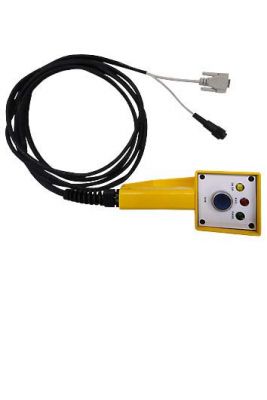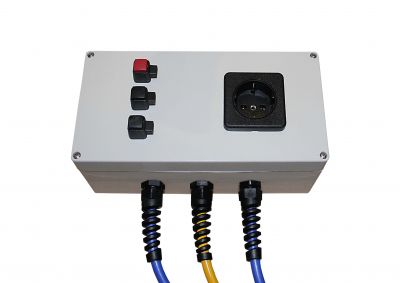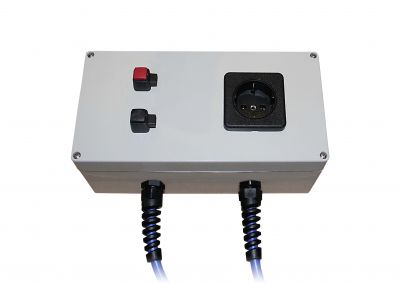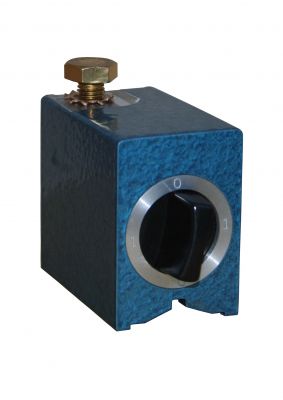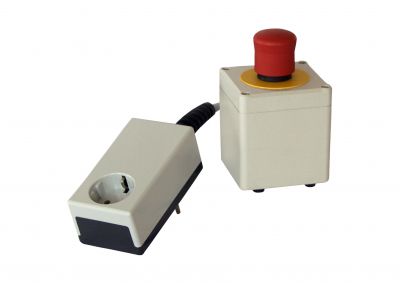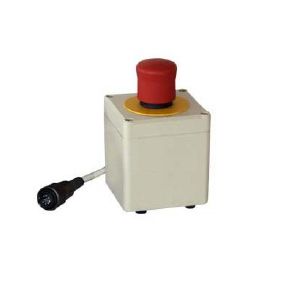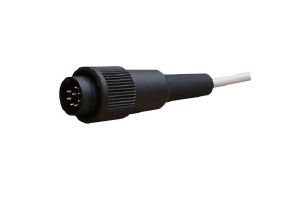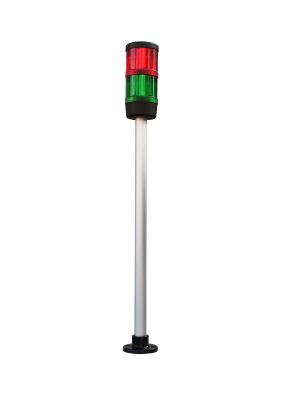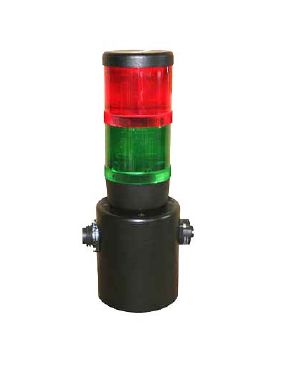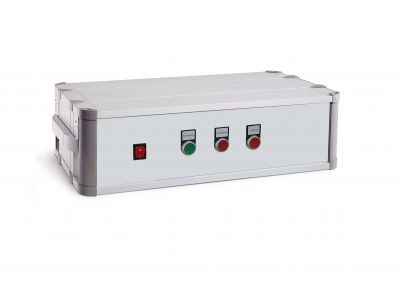Certificeret kvalitetsstyringssystem
Højspændingstestere samt testbure, testdukker, kabler og meget mere
Den robuste højspændingstestere til test af elektrisk isolationsevne og dielektrisk styrke kan findes her. Alle højspændingstestere er ideelle til sikker højspændingstestning, uanset om det er i produktionen eller i laboratoriet, f.eks. til typetestning.
Køb online nu højspændingstester:
- Including cable-set for safety tester:
400 series (ST400) - For Installation in test wagon including wiring
- Start button and protective earth
- Two hand operation with HV probe
- Ergonomically design
- Including cable-set for safety tester:
400 series (ST400), UX36, UH36 - Ergonomically design housing
- 3 pressure clamps L,N and PE
- 230V socket or others on demand
- Connecting cable: 2 m
- Including cable-set for safety tester:
400 series (ST400), UX36, UH36 - Ergonomically design housing
- Voltage: 6 KVAC, 8 KVDC
- 2 pressure clamps L/N and PE
- 230V socket or others on demand
- Connecting cable: 2 m
- With magnetic switch
- With screw joint for connection of a cable socket
- For magnetic contacting
- Conforming to all standards
- Emergency stop for tester
- Load: 16 A
- Cable length: 5 m
- Emergency stop with 5 m cable
- Circuit of the tester could be opened
- Not possible to switch on high-voltage again
- Log printer in own plastic table casing
- Not to be built-in.
- Baud rate 9600
- Devices: 36 series
- Mounted on test trolley
- Total hight of lamps 1850mm
- Standard: EN 50191, VDE0104
- Lights: Red/Green
- Function: operation, switch on, ready
- Cable length: 2m
- Total height is 1800 mm
- With 2 m connection cable
- Direct connection to the tester
- Signal lamp according to EN 50191
- Devices: 400 series
- Mounted on tube extension
- Total hight of lamps 1170mm
- Standard: EN 50191, VDE0104
- Lights: Red/Green
- Function: operation, switch on, ready
- Cable length: 3m
- Devices: 400 series
- Mounted on test trolley
- Total hight of lamps 1850mm
- Standard: EN 50191, VDE0104
- Lights: Red/Green
- Function: operation, switch on, ready
- Cable length: 3m
- For connection of multiple signal lamps
- According to EN 50191
- Specification of the risk level
Højspændingstestere bestemmer isolationsstyrke og spændingsmodstand
Ved afstandsmåling gælder omtrent reglen: 1000V = 1mm afstand. Højspændingstestere, der anvendes i styktest i henhold til VDE-standarder, arbejder normalt med spændinger op til ca. 6 kV.
Alternativt fås der specielle højspændingstestere og anlæg med spændinger på 7 kV, 10 kV, 12 kV, 14 kV, 20 kV, 30 kV, 50 kV, 100 kV, 150 kV og 300 kV samt mellemniveauer. Højspændingstestere i denne klasse er meget kraftige og anvendes primært i store testfelter og i kabelindustrien. Det medfølgende tilbehør til højspændingstestere omfatter: testpistoler, to-håndsbetjening, testbure, HV-advarselslamper og skilte med “Advarsel: højspændingstest”. De elektroniske højspændingstestere kan nemt styres og aflæses via den komfortable testsoftware ST®Meter eller Data View – standardtilsluttet via USB, LAN, CAN-bus eller RS232. Til montering i 19” testsystemer findes et monteringssæt.
Sourcetronic Højspændingstester ST9201
I denne video præsenteres højspændingstesteren ST9201, dens funktioner og varianter.
Hvordan fungerer højspændingstesten?
Højspændingstesten udføres på apparater i beskyttelsesklasse I (med PE-beskyttelsesleder) og beskyttelsesklasse II (uden PE-beskyttelsesleder). Her kontrolleres, om isolationen af de strømførende ledere samt sikkerhedsafstanden til huset opfylder kravene.
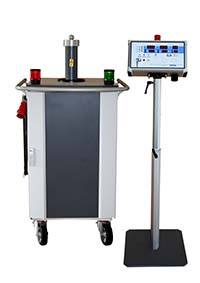
En HV-test anses i princippet for “GOD”, når der ikke løber nogen strøm. Ved en AC-højspændingstest på et testemne med kapacitiv opførsel vil der dog løbe en lille strøm. Derfor har de fleste højspændingstestere en indstillingsmulighed for teststrømmen. Som tommelfingerregel for spændingen ved en HV-test anvendes den dobbelte nominelle spænding for testemnet plus 1000 V. For et 230-volts apparat bliver det således: 1000 V + 2 x 230 V = 1460 V (≈1500 V).
Der skelnes mellem AC- og DC-højspændingstests. VDE (Foreningen for Elektroteknik, Elektronik og Informationsteknik) godkender i stigende grad DC-HV-tests i produktionsvirksomheder, da de på grund af manglende frekvens er mindre farlige for mennesker, især for hjertet. For arbejdssikkerheden gælder de bindende forskrifter fra arbejdstilsynet (EN 50191). Ifølge disse behøver arbejdspladsen ikke at blive sikret særskilt, hvis man tester med AC-højspænding op til 3 mA eller DC-højspænding op til 12 mA. DC-højspændingstesten har derfor den fordel, at der op til 12 mA ikke kræves særlige sikkerhedsforanstaltninger.
Arbejdssikkerhed ved håndtering af højspændingstestere:
a) Højspændingstests med strøm: |>3 mA/AC eller |>12 mA/DC
- Særlig HV-testrum eller
- Kæde, advarselsskilt, advarselslamper, testpistoler / testbur / to-håndsbetjening
b) Højspændingstests med strøm: I - ingen særlige forholdsregler
- eller kun forholdsregler mod “sekundære ulykker”, såsom forskrækkelsesbevægelser efter et elektrisk stød
Højspændingstests på testemner med støjundertrykkelseskondensatorer eller Y-kondensatorer kan udføres med både AC og DC. Selv ved DC-højspændingstest kan man ved hjælp af ladningsstrømsmålingen få information om den indbyggede støjkondensator.
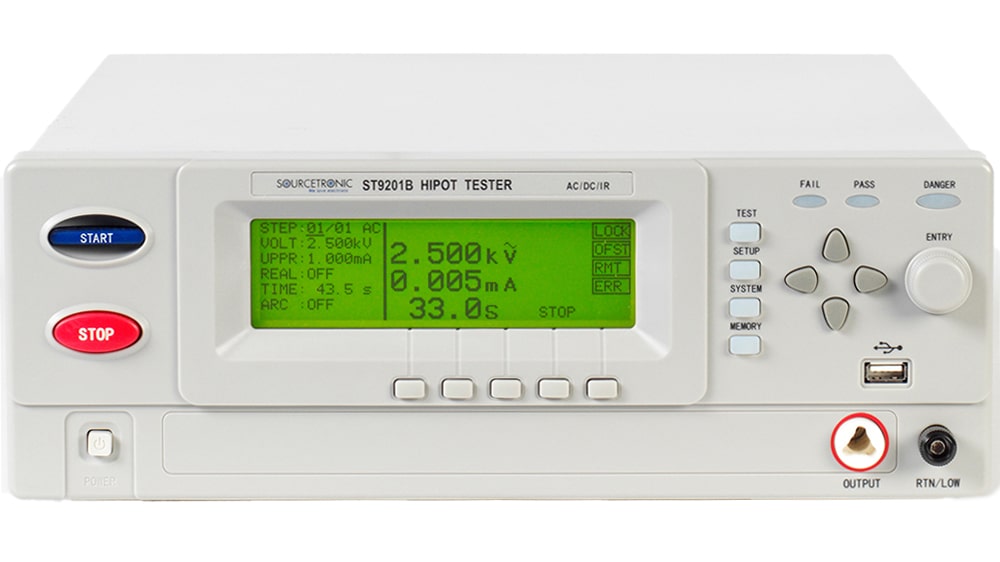
FAQ: Hjælp og tips
Nedenfor finder du hjælp og tips til højspændingstestere, højspændingstestere og højspændingsanlæg fra Sourcetronic – fra generelle spørgsmål til specifikke spørgsmål om de enkelte apparattyper finder du her nogle af de mest almindelige spørgsmål:
Hvordan indlæser jeg firmwareopdateringen på ST9201? Hvordan skal en højspændingstestplads sikres? Hvad betyder strømbegrænset?

